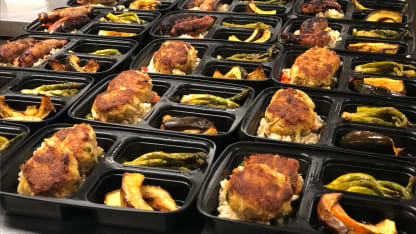BOSTON -For much of the spring and early summer, the NHL and NHLPA held lengthy and intricate discussions about how they could safely get the sport back up and running amidst a global crisis. The negotiations - which also included a new CBA extension - centered on comprehensive health protocols that would ensure the players, coaches, and staff would be as protected as possible during a return to play with the COVID-19 pandemic still surging across the globe.
At the same time, Bruins team chef Keith Garman was doing his own planning.
Knowing that part of the return to play agreement included the temporary elimination of team meals in an effort to prevent players from gathering in the kitchen and lounge, Garman got to work on developing the safest and most efficient way to feed roughly 50 players and staff members for the duration of the Bruins' two-week training camp - all while having zero contact with any of them.
Digging In
Bruins chef Keith Garman has had to revamp meal prep, delivery amid pandemic
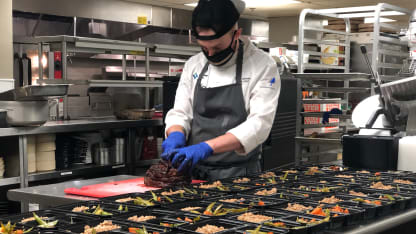
It was a herculean task, but one that Garman embraced knowing it would be a vital part of keeping the players, coaches, and staff safe ahead of the team's trip to Toronto.
"Definitely very unique, nothing like we've ever done before," said Garman, now in his second full season as the Bruins' team chef. "A new way of doing things for a lot of people, but a good challenge for sure. We had kind of preemptively discussed what was gonna happen in the coming weeks leading up to camp.
"It was kind of like, 'Well, how are we gonna be able to feed the guys and do it in a way that's minimizing the touchpoints, being safe and allowed for the league protocol?'
"This is the best-case scenario we came up with, making the meals [at TD Garden] where we're out of the way with everything pre-packaged, individual, and labeled."
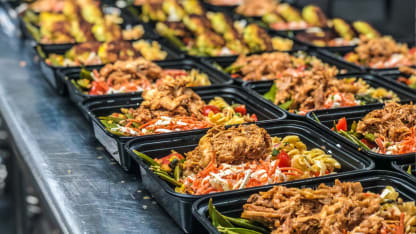
The Plan
In order for the Bruins to safely resume their quest for the Stanley Cup this summer, it was clear that everyone in the organization would have to do their part - from ownership and management, to the coaches and players, to the equipment and medical staffs, to the public relations personnel, to the rink employees at Warrior Ice Arena, to so many others in between.
With that in mind, Garman became a vital piece in building the team's new routine. With guidance from Bruins general manager Don Sweeney, president Cam Neely, and team nutritionist Julie Nicoletti, he mapped out a plan that included lunch and dinner options for each day that the team would report to the rink during their two-week practice period.
The most important objective? Providing the players with healthy, nutritious meals that would limit their need to order out or go to restaurants. That meant that instead of preparing breakfast and lunch - Garman's usual routine during the season - he would switch to preparing lunch and dinner.
"I'm enjoying [the dinner part] because I'm able to make some more creative options and I think the guys are enjoying that fact too," said Garman. "And then you have the Black Aces, the guys that maybe don't have a family at home that have meals ready for them. It's kind of limiting them from going out to restaurants, one less thing they have to worry about.
"All they have to worry about is showing up to the rink on time and focusing on hockey. They don't have to worry about where they're going to get dinner, if it's going to be good, if it's going to be healthy. We're knocking that all out with this."
The plan also included Garman moving his operation out of the kitchen inside the team's facility at Warrior Ice Arena to a remote location at TD Garden in an effort to limit touchpoints like counters and buffet tables and create a more sterile environment.
While Garman's normal day-to-day interactions with the players and staff are often vital to developing a rapport and properly catering to their needs, he understood the importance of being distant during such an unprecedented situation.
"It's definitely a little weird for sure," said Garman. "Usually I'm able to know that this guy got what he needed, that guy got what he needed. Now I'm just going off the pre-orders. It's a little different to know what's going on…there's obviously the natural camaraderie and stuff of that nature which is kind of missing.
"But the communication has picked up in other areas, a lot of communication from the trainers, a lot of communication from [team travel and services coordinator] Whitney [Delorey]…trying to keep me in the loop with what is going on.
"It's been a good team communication. They let me know what's going on when I can't physically be there. Personally, I'd love to be there, but you've got to do what's right for everybody."
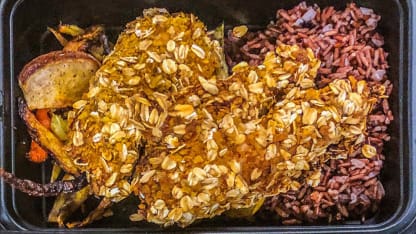
The Menu
Under normal circumstances, Garman serves a buffet-style breakfast and lunch inside the Warrior Ice Arena kitchen. While some players request personalized orders, the majority come and go before and after practice or morning skate to load up their plates as they please with whatever is on the menu for that day.
Now, the operation has become far more individualized. With a finite two-week practice period on the schedule, Garman has been able to map out a menu in advance and send it to the players and staff, who text in their selections for each day at the start of the week.
They choose from a fish, meat, or vegetarian option for both lunch and dinner, while everyone receives the same sides, with the exception of those with allergies.
On Day 6 of camp, for example, 42 players and staff members chose from three protein options for lunch: crab cakes, chicken sausage, or vegan risotto. The sides were spaghetti squash, asparagus, and creamy rice. For dinner, the protein options were swordfish, roast beef, and tofu stir fry, with roasted carrots, snap peas, and bulgur as the sides.
"This is an even more detailed way of doing it because it's individualized," said Garman. "What we've been able to do is create a week's worth of menus for lunch and dinner, pulling from a lot of classics, what we know the guys really like...from that, we've been able to build a day-to-day list, label everything so all we have to do is assemble. It's definitely a little bit more personalized than usual."
With Garman now providing dinner, he has been able to open up his catalogue of recipes and introduce the players to a number of meals that they otherwise wouldn't see within the normal rotation throughout the season.
"You're used to doing so many different things for the guys at lunch, not really offering dinner to them," said Garman. "There's quite a few things in my repertoire that I've never really been able to get to them or show them because it just didn't make sense for the lunch period, the time frame. With that option being available for them now, it's been nice to dig into a few of those."
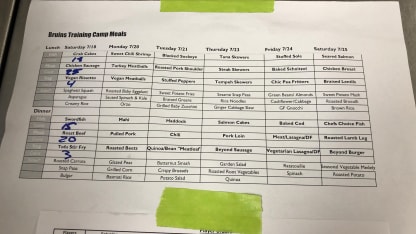
The Preparation
On the days that the Bruins have practiced in the morning, Garman arrives at TD Garden around 6 a.m. to begin his preparations. After a couple of hours in the kitchen, the Pennsylvania native transitions to packaging the food, creating a far different routine than he is accustomed to.
"My days are definitely different for sure," said Garman. "I'm kind of having to batch things out a lot more ahead of time with this set up, whereas when I was at Warrior, spatially and how we execute the meals, I could kind of just go from scratch and start fresh every day, whereas with this I kind of have to do everything in a bit more bulk and ahead of time.
"There's also no breakfast. That was kind of my time where if we were doing it at Warrior, I could time it and start lunch simultaneously. Here it's kind of just going straight into it from the get-go and trying to get it to the guys before they come off the ice."
While the kitchen is always required to be sanitized even under the most normal of circumstances, Garman also spends time doing some extra cleaning of his workspace to ensure that the containers and surface areas are safe.
"You want to take extra care, especially with these kinds of things," said Garman. "Right before we put the individual containers down, disinfect again, wash your hands, put the gloves on, keep the containers separate from everything else and then keep it one by one as we go."
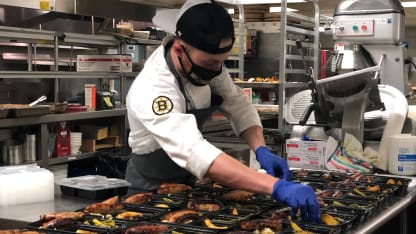
The Packaging
The most intensive part of Garman's day is, perhaps, the packaging of the meals. Taking nearly an hour each day, Garman loads roughly 100 meals into plastic, to-go containers, all of which are pre-labeled with the name of the player or staff member, as well as the meal that's inside.
The easy part is loading up the sides. With the vast majority of the players and staff getting the same sides, Garman can quickly and efficiently tuck them neatly into the containers.
When it comes to the entrées, Garman refers to a chart that lists out each individual's preference, allowing him to count out the proper number of each. On Day 6 of camp, the numbers looked like this:
Lunch
Crab cakes | 18
Chicken sausage | 25
Vegan risotto | 4
Dinner
Swordfish | 15
Roast beef | 20
Tofu stir fry | 3
"I have a little sheet that already has a pre-counted amount of who's getting what," said Garman. "I start with the highest amount and work backwards from there…with the exception of anybody with a specific allergy, all the sides that are coming in here the same. The only difference is the protein that goes on top.
"Within that, I'm able to go quickly through this stage where we're just putting the starch down - the creamy rice, that will be the first thing down, then we'll go through and put the veggies and then the protein."
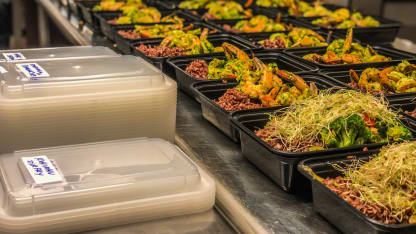
The Transport
For Garman - and almost every chef - it is far from an ideal way to present their creations. He would much prefer the food to be served fresh and on a plate. But that is not possible now, forcing Garman to adjust the way he prepares the meals.
Knowing that the players will likely have to re-heat the food, he is leaving a slight bit of wiggle room and pulling the food off the stove or out of the oven a tad sooner than usual so it's not too well-done when it's time to consume.
"I think the key to doing it well is just keeping what we're making simple and not trying to reinvent the wheel and just execute the simple well with good quality ingredients," said Garman. "I think that can go a long way. Kind of taking into the fact that it's gonna sit between transportation and also gonna get reheated by the players in the microwave or they'll take it out and put it in the oven, so maybe slightly compensating for that where as if I was serving it normally I might cook it 100 percent."
Once everything is packaged, Garman finishes up by loading them into a portable storage unit that keeps the food warm. The meals are then picked up by a member of the equipment or training staff and driven to Brighton where they are dropped off at the team facility for the players to pick up on their way out of the rink.
"[We wanted] the right containers that are gonna work, organizing the supply transfer between here and Warrior, trying to figure that out because that's new for everybody," said Garman. "How do we get these packed up in an easy way and also time it with the equipment guys and make sure, bottom line, that the quality doesn't suffer too much.
"From a timing perspective, we're trying to get it so the meals hit containers and spend minimal time in travel and then the guys pick them up right as they get off the ice and that's that."
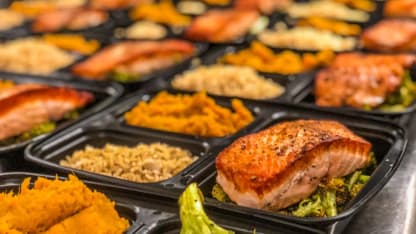
The Teamwork
Despite having to return to work at a distance, Garman is thrilled to have a part in helping the Bruins gear up another run at the Stanley Cup.
"I've been anxious to get back for a while," said Garman. "I would have felt a little bit like I let people down if I wasn't able to contribute. I know it is what it is, but we were having a great year…hopefully jump in here and finish it off on a good note. Do my part here for fuel and flavor for the guys, and hopefully they can have a deep run."
With that kind of support from throughout the organization, the players know they are not alone on this journey. And they realize what a luxury it has been to have one less thing to worry about during a time of such uncertainty.
"We can't thank them enough for the work that they've done throughout this time," said Matt Grzelcyk. "I'm sure it's been quite stressful for them as well. That really helps us put the right things in our bodies and it's just one less thing to worry about, not having to go in public as much or have to go out to a restaurant and risk bringing in that illness and bringing it to your teammates. That's been a huge help for sure.
"It's kind of tough not being able to sit and have a nice breakfast and lunch with your teammates. I think that's something that I certainly look forward to during the year, but just realize that it could be a lot worse. We would love to thank them in a big way. Hopefully we get to see them soon enough when things boil over."
